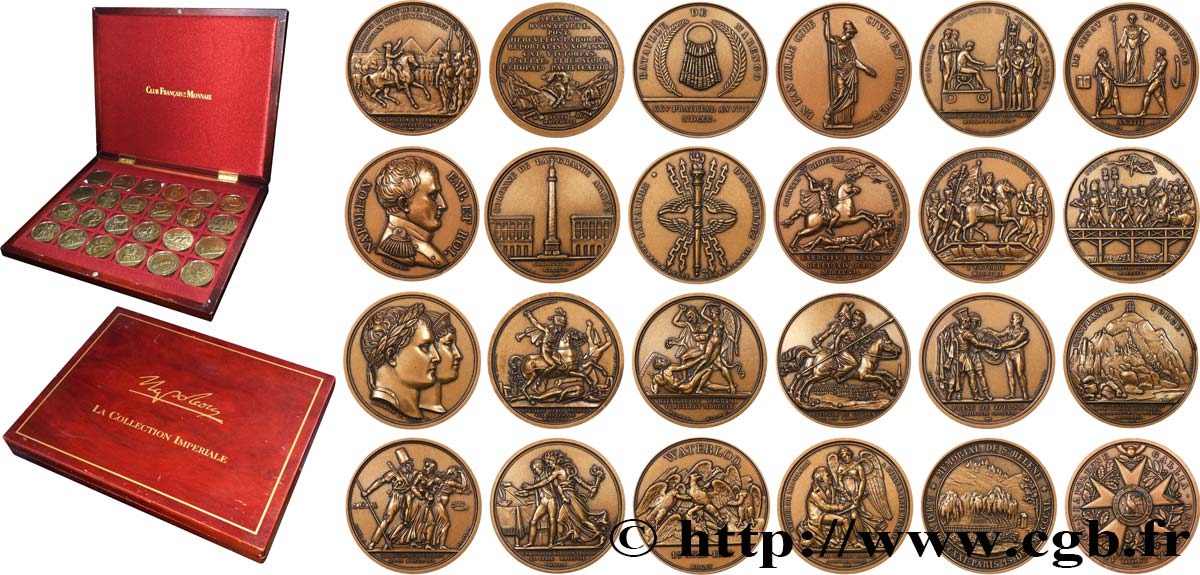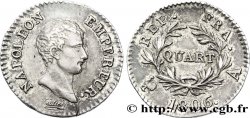fme_708699 - PREMIER EMPIRE / FIRST FRENCH EMPIRE Coffret de 24 médailles, refrappe, Histoire de Napoléon Ier
400.00 €(Approx. 468.00$ | 348.00£)
Quantity
Add to your cart

Type : Coffret de 24 médailles, refrappe, Histoire de Napoléon Ier
Date: n.d.
Metal : bronze
Diameter : 42 mm
Orientation dies : 12 h.
Weight : 1793,40 g.
Edge : lisse
Puncheon : corne d’abondance
Coments on the condition:
Exemplaires présentant quelques coups et rayures. Bel ensemble. La boîte présente quelques coups et rayures
Predigree :
Cet exemplaire provient de la Collection MARINECHE
Obverse
Obverse legend : (DIVERSES LÉGENDES).
Reverse
Reverse legend : ANÉPIGRAPHE.
Reverse description : Aigle, ailes éployées, couronné par une Victoire, les serres sur un foudre, signé : DENON / D.T // JALEY F. / 1807 .
Commentary
Attention ! En fonction du lieu d’expédition, ce coffret peut donner lieu à des frais de port supplémentaires.
Be aware that in function of the shipping place, this box of medals may rise the shipping fees.
Ce coffret en bois de 24 médailles, timbré LA COLLECTION IMPERIALE, édité par le Club français de la Monnaie, retrace le parcours et histoire de Napoléon Ier :
- Alexandre Bonaparte, Octobre 1797, poids : 48,05g, diamètre : 40,5 mm
- Conquête de l’Egypte, 1798, poids : 47,15g, diamètre : 41,5 mm
- Bataille de Marengo, juin 1800; poids : 47,72g, diamètre : 41 mm
- Code civil, an XII (1803-1804), poids : 48,12g, diamètre : 41 mm
- Honneur légionnaire aux braves de l’Armée, Août 1804, poids : 47,37g, diamètre : 41 mm
- Le Sénat et le peuple, an XIII (1804-1805), poids : 47,49g, diamètre : 40,5 mm
- Colonne de la Grande Armée, 1805; poids : 47,65g, diamètre : 41,5 mm
- Bataille d’Austerlitz, décembre 1805; poids : 49,18g, diamètre : 41,5 mm
- Passage du Rhin à Mayence, octobre 1806, poids : 49,51g, diamètre : 41,5 mm
- Armée prussienne détruite à Iéna, Octobre 1806, poids : 48,46g, diamètre : 41,5 mm
- Buste Napoléon Empereur et Roi par Brenet, 1807, poids : 48,81g, diamètre : 41 mm
- Iterum Ibidem, Juillet 1809, poids : 49,85g, diamètre : 41,5 mm
- Bataille de Wagram, Juillet 1809, poids : 45,78g, diamètre : 40,5 mm
- Mariage Napoléon Ier et Marie Louise, poids : 48,61g, diamètre : 41,5 mm
- Prise de Wilna, juin 1812; poids : 47,39g, diamètre : 41 mm
- Bataille de la Moskowa, septembre 1812; poids : 49,57g, diamètre : 41 mm
- Bataille de Lutzen, mai 1813; poids : 49,48g, diamètre : 41,5 mm
- Confiance et force, Défense de l’Empire, 1813; poids : 49,50g, diamètre : 41 mm
- Malheurs de la guerre, Mars 1814, poids : 47,81g, diamètre : 40,5 mm
- Abdication de Napoléon Ier, Avril 1814, poids : 48,91g, diamètre : 41 mm
- Waterloo, 1815, poids : 46,71g, diamètre : 42 mm
- Séjour de Napoléon à l’Île Sainte Hélène, octobre 1815, poids : 48,30g, diamètre : 41 mm
- Mémorial de Sainte Hélène, Mai 1821; poids : 47,95g, diamètre : 40,5 mm
- Légion d’honneur, poids : 47,84g, diamètre : 41 mm
POIDS TOTAL avec le coffret : 1793,40g.
Please note! Depending on the shipping location, this box may incur additional shipping costs..
Be aware that in function of the shipping place, this box of medals may raise the shipping fees.
This wooden box of 24 medals, stamped LA COLLECTION IMPERIALE, published by the French Mint Club, retraces the journey and history of Napoleon I: - Alexandre Bonaparte, October 1797, weight: 48.05g, diameter: 40.5 mm - Conquest of Egypt, 1798, weight: 47.15g, diameter: 41.5 mm - Battle of Marengo, June 1800; weight: 47.72g, diameter: 41 mm - Civil Code, year XII (1803-1804), weight: 48.12g, diameter: 41 mm - Legionary honor to the brave of the Army, August 1804, weight: 47.37g, diameter: 41 mm - The Senate and the people, year XIII (1804-1805), weight: 47.49g, diameter: 40.5 mm - Column of the Grande Armée, 1805; weight: 47.65g, diameter: 41.5 mm - Battle of Austerlitz, December 1805; weight: 49.18g, diameter: 41.5 mm - Crossing of the Rhine at Mainz, October 1806, weight: 49.51g, diameter: 41.5 mm - Prussian army destroyed at Jena, October 1806, weight: 48.46g, diameter: 41.5 mm - Bust of Napoleon Emperor and King by Brenet, 1807, weight: 48.81g, diameter: 41 mm - Iterum Ibidem, July 1809, weight: 49.85g, diameter: 41.5 mm - Battle of Wagram, July 1809, weight: 45.78g, diameter: 40.5 mm - Marriage of Napoleon I and Marie Louise, weight: 48.61g, diameter: 41.5 mm - Capture of Wilna, June 1812; weight: 47.39g, diameter: 41 mm - Battle of Borodino, September 1812; weight: 49.57g, diameter: 41 mm - Battle of Lutzen, May 1813; weight: 49.48g, diameter: 41.5 mm - Confidence and Strength, Defense of the Empire, 1813; weight: 49.50g, diameter: 41 mm - Misfortunes of War, March 1814, weight: 47.81g, diameter: 40.5 mm - Abdication of Napoleon I, April 1814, weight: 48.91g, diameter: 41 mm - Waterloo, 1815, weight: 46.71g, diameter: 42 mm - Napoleon's stay on the Island of Saint Helena, October 1815, weight: 48.30g, diameter: 41 mm - Memorial of Saint Helena, May 1821; weight: 47.95g, diameter: 40.5 mm - Legion of Honor, weight: 47.84g, diameter: 41 mm TOTAL WEIGHT with the box: 1793.40g
Be aware that in function of the shipping place, this box of medals may rise the shipping fees.
Ce coffret en bois de 24 médailles, timbré LA COLLECTION IMPERIALE, édité par le Club français de la Monnaie, retrace le parcours et histoire de Napoléon Ier :
- Alexandre Bonaparte, Octobre 1797, poids : 48,05g, diamètre : 40,5 mm
- Conquête de l’Egypte, 1798, poids : 47,15g, diamètre : 41,5 mm
- Bataille de Marengo, juin 1800; poids : 47,72g, diamètre : 41 mm
- Code civil, an XII (1803-1804), poids : 48,12g, diamètre : 41 mm
- Honneur légionnaire aux braves de l’Armée, Août 1804, poids : 47,37g, diamètre : 41 mm
- Le Sénat et le peuple, an XIII (1804-1805), poids : 47,49g, diamètre : 40,5 mm
- Colonne de la Grande Armée, 1805; poids : 47,65g, diamètre : 41,5 mm
- Bataille d’Austerlitz, décembre 1805; poids : 49,18g, diamètre : 41,5 mm
- Passage du Rhin à Mayence, octobre 1806, poids : 49,51g, diamètre : 41,5 mm
- Armée prussienne détruite à Iéna, Octobre 1806, poids : 48,46g, diamètre : 41,5 mm
- Buste Napoléon Empereur et Roi par Brenet, 1807, poids : 48,81g, diamètre : 41 mm
- Iterum Ibidem, Juillet 1809, poids : 49,85g, diamètre : 41,5 mm
- Bataille de Wagram, Juillet 1809, poids : 45,78g, diamètre : 40,5 mm
- Mariage Napoléon Ier et Marie Louise, poids : 48,61g, diamètre : 41,5 mm
- Prise de Wilna, juin 1812; poids : 47,39g, diamètre : 41 mm
- Bataille de la Moskowa, septembre 1812; poids : 49,57g, diamètre : 41 mm
- Bataille de Lutzen, mai 1813; poids : 49,48g, diamètre : 41,5 mm
- Confiance et force, Défense de l’Empire, 1813; poids : 49,50g, diamètre : 41 mm
- Malheurs de la guerre, Mars 1814, poids : 47,81g, diamètre : 40,5 mm
- Abdication de Napoléon Ier, Avril 1814, poids : 48,91g, diamètre : 41 mm
- Waterloo, 1815, poids : 46,71g, diamètre : 42 mm
- Séjour de Napoléon à l’Île Sainte Hélène, octobre 1815, poids : 48,30g, diamètre : 41 mm
- Mémorial de Sainte Hélène, Mai 1821; poids : 47,95g, diamètre : 40,5 mm
- Légion d’honneur, poids : 47,84g, diamètre : 41 mm
POIDS TOTAL avec le coffret : 1793,40g.
Please note! Depending on the shipping location, this box may incur additional shipping costs..
Be aware that in function of the shipping place, this box of medals may raise the shipping fees.
This wooden box of 24 medals, stamped LA COLLECTION IMPERIALE, published by the French Mint Club, retraces the journey and history of Napoleon I: - Alexandre Bonaparte, October 1797, weight: 48.05g, diameter: 40.5 mm - Conquest of Egypt, 1798, weight: 47.15g, diameter: 41.5 mm - Battle of Marengo, June 1800; weight: 47.72g, diameter: 41 mm - Civil Code, year XII (1803-1804), weight: 48.12g, diameter: 41 mm - Legionary honor to the brave of the Army, August 1804, weight: 47.37g, diameter: 41 mm - The Senate and the people, year XIII (1804-1805), weight: 47.49g, diameter: 40.5 mm - Column of the Grande Armée, 1805; weight: 47.65g, diameter: 41.5 mm - Battle of Austerlitz, December 1805; weight: 49.18g, diameter: 41.5 mm - Crossing of the Rhine at Mainz, October 1806, weight: 49.51g, diameter: 41.5 mm - Prussian army destroyed at Jena, October 1806, weight: 48.46g, diameter: 41.5 mm - Bust of Napoleon Emperor and King by Brenet, 1807, weight: 48.81g, diameter: 41 mm - Iterum Ibidem, July 1809, weight: 49.85g, diameter: 41.5 mm - Battle of Wagram, July 1809, weight: 45.78g, diameter: 40.5 mm - Marriage of Napoleon I and Marie Louise, weight: 48.61g, diameter: 41.5 mm - Capture of Wilna, June 1812; weight: 47.39g, diameter: 41 mm - Battle of Borodino, September 1812; weight: 49.57g, diameter: 41 mm - Battle of Lutzen, May 1813; weight: 49.48g, diameter: 41.5 mm - Confidence and Strength, Defense of the Empire, 1813; weight: 49.50g, diameter: 41 mm - Misfortunes of War, March 1814, weight: 47.81g, diameter: 40.5 mm - Abdication of Napoleon I, April 1814, weight: 48.91g, diameter: 41 mm - Waterloo, 1815, weight: 46.71g, diameter: 42 mm - Napoleon's stay on the Island of Saint Helena, October 1815, weight: 48.30g, diameter: 41 mm - Memorial of Saint Helena, May 1821; weight: 47.95g, diameter: 40.5 mm - Legion of Honor, weight: 47.84g, diameter: 41 mm TOTAL WEIGHT with the box: 1793.40g








 Report a mistake
Report a mistake Print the page
Print the page Share my selection
Share my selection Ask a question
Ask a question Consign / sell
Consign / sell
 Full data
Full data










